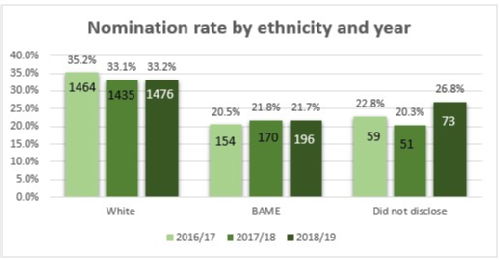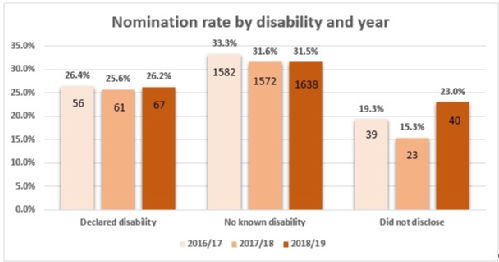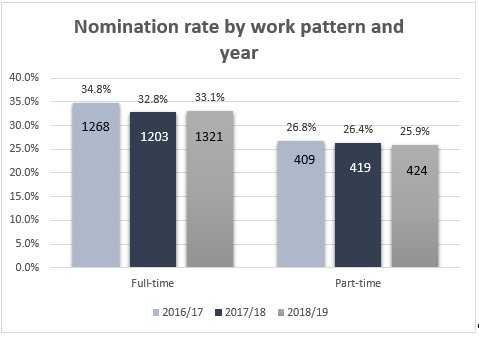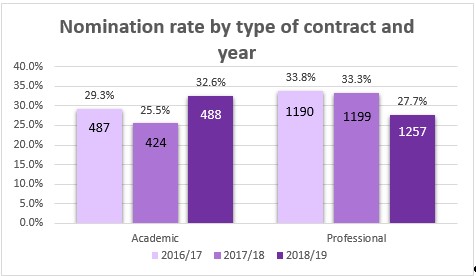Pay Gaps Revisited
The eagle-eyed amongst you might have spotted that the University recently published its annual pay gap report; if you haven’t seen this, it’s available here. I’m not going to repeat what the report says but what I do want to do is share a bit more data and insight.
First as context, pay gaps directly compare (for all grades) the hourly pay of staff across different sub groups. We are required to report pay gaps by gender but we have also chosen to report our ethnicity and disability pay gap. The Gender Pay Gap has changed little since our first report in 2017; the Ethnicity Pay Gap is showing signs of improvement while the Disability Pay Gap has deteriorated. For the first time this year, we have also calculated a Sexual Orientation Pay Gap (but we have not yet started to report this). I’ve summarised our figures in the table below. The percentages indicate the extent to which pay for men exceeds that for women, (and white staff v ethnic minority, not disabled v disabled and heterosexual v LGBT+).
|
31 March 2017 |
31 March 2018 |
31 March 2019 |
31 March 2020 |
|
|---|---|---|---|---|
|
Gender GAP |
||||
|
Mean gender pay gap in hourly pay |
26.5% |
26.0% |
25.9% |
26.8% |
|
Median gender pay gap in hourly pay |
23.4% |
25.3% |
24.7% |
23.3% |
|
Ethnicity |
||||
|
Mean ethnicity pay gap in hourly pay |
8.6% |
6.9% |
8.2% |
7.4% |
|
Median ethnicity pay gap in hourly pay |
7.2% |
5.1% |
4.2% |
5.7% |
|
Disability |
||||
|
Mean disability pay gap in hourly pay |
11.4% |
12.8% |
13.0% |
17.9% |
|
Median disability pay gap in hourly pay |
9.9% |
13.3% |
14.0% |
18.6% |
|
Sexual Orientation (LGBT+) |
||||
|
Mean LGBT+ pay gap in hourly pay |
- |
- |
- |
-2.7% |
|
Median LGBT+ pay gap in hourly pay |
- |
- |
- |
4.1% |
The University’s Pay Action Group has undertaken extensive analysis to understand more about the nature and causes of our pay gaps. It’s a complex picture – there are lots of factors that affect pay levels and progression. But we’re taking initiatives in a number of areas and I’ll say a bit more about this at the end of this blog.
If we look at gender pay initially and make some comparisons across grades, we see the following:
|
Mean Gender Pay Gap |
2018 |
2019 |
2020 |
% Female (2020) |
|---|---|---|---|---|
|
FA 1 |
-0.5% |
1.6% |
2.7% |
73% |
|
FA 2 |
-0.5% |
4.7% |
3.2% |
50% |
|
FA 3 |
0.9% |
2.1% |
2.7% |
73% |
|
FA 4 |
0.0% |
1.3% |
2.2% |
65% |
|
FA 5 |
1.1% |
2.1% |
2.9% |
57% |
|
FA 6 |
0.6% |
0.8% |
6.8% |
52% |
|
FA 7 |
0.8% |
2.1% |
2.1% |
49% |
|
FA 8 |
1.1% |
2.5% |
3.1% |
42% |
|
FA 9 |
5.6% |
8.2% |
12.4% |
26% |
|
CLINICAL |
10.3% |
26.1% |
28.1% |
40% |
|
Grand Total |
26.0% |
25.9% |
26.8% |
52% |
There are currently some marked gaps in Clinical roles, at FA9 and also at FA6; in other areas the gaps are much smaller. But the lower grades are dominated by women and the higher grades are dominated by men. This is sometimes described as vertical labour market segregation. Not surprisingly, if women are disproportionately in lower paid roles and men are disproportionately in higher paid roles, then small differences for individuals within will become a larger pay gap overall.
The table below looks at this in a different way and asks “what happens if we simply equalise salary with all grades (and for sub sets of grades)” – and the resulting pay gaps are in the first column. It also asks “what happens if we equalise the proportions of men and women across all grades” – and the results are in the second column”.
|
Pay Gap when salaries are equalised within grades |
Pay Gap when staff distributions are equalised within grades |
|
|---|---|---|
|
For all grades |
22.37% |
6.42% |
|
For bottom 3 grades |
26.01% |
21.35% |
|
For top 3 grades |
24.41% |
15.25% |
|
For top 3 & clinical grades |
23.75% |
14.55% |
|
For middle 3 grades |
21.87% |
24.95% |
What this tells us is that if we want to address the gender pay gap, we need to address the uneven distribution of staff by gender across different grades and we will have to do this at all levels – we can’t just focus on subsets.
The problem of vertical labour market segregation also plays a role in other pay gaps. For both disability and ethnicity, there is a similar challenge; disabled and ethnic minority staff are disproportionately represented in the lower grades.
|
BAME |
White |
Pay Gap |
% BAME |
|
|---|---|---|---|---|
|
FA 1 |
£8.75 |
£8.59 |
-1.81% |
26% |
|
FA 2 |
£9.45 |
£9.64 |
1.98% |
11% |
|
FA 3 |
£10.33 |
£10.61 |
2.69% |
15% |
|
FA 4 |
£12.15 |
£12.36 |
1.72% |
13% |
|
FA 5 |
£14.09 |
£13.96 |
-0.93% |
18% |
|
FA 6 |
£17.93 |
£18.42 |
2.64% |
26% |
|
FA 7 |
£23.39 |
£22.92 |
-2.05% |
17% |
|
FA 8 |
£28.46 |
£28.61 |
0.53% |
13% |
|
FA 9 |
£55.09 |
£50.59 |
-8.89% |
10% |
|
CLINICAL |
£59.56 |
£50.02 |
-19.07% |
25% |
|
Grand Total |
£19.45 |
£21.02 |
7.45% |
18% |
|
Disabled |
Not Disabled |
Pay Gap |
% Disabled |
|
|---|---|---|---|---|
|
FA 1 |
£8.67 |
£8.63 |
-0.49% |
6% |
|
FA 2 |
£9.66 |
£9.64 |
-0.20% |
10% |
|
FA 3 |
£10.45 |
£10.58 |
1.23% |
7% |
|
FA 4 |
£12.30 |
£12.34 |
0.32% |
6% |
|
FA 5 |
£14.93 |
£13.93 |
-7.19% |
6% |
|
FA 6 |
£17.15 |
£18.31 |
6.35% |
5% |
|
FA 7 |
£22.17 |
£23.04 |
3.75% |
4% |
|
FA 8 |
£28.01 |
£28.56 |
1.91% |
3% |
|
FA 9 |
£51.40 |
£51.36 |
-0.07% |
3% |
|
CLINICAL |
£27.30 |
£52.92 |
48.41% |
3% |
|
Grand Total |
£17.27 |
£21.04 |
17.90% |
5% |
When looking at the ethnicity pay gap we also need to consider sub-groups – and this year we have disaggregated the ethnicity data as shown below.
|
Black |
Asian |
Mixed |
Other |
|
|---|---|---|---|---|
|
Mean ethnicity pay gap in hourly pay |
27.8% |
2.7% |
12.1% |
10.0% |
|
Median ethnicity pay gap in hourly pay |
25.5% |
1.7% |
1.7% |
-3.0% |
|
Proportion of staff in when divided into 4 groups ordered from lowest to highest pay |
||||
|
Q1 |
4% |
11% |
2% |
1% |
|
Q2 |
2% |
13% |
2% |
1% |
|
Q3 |
1% |
14% |
2% |
2% |
|
Q4 |
1% |
10% |
1% |
1% |
This highlights that the relatively low overall ethnicity pay gap hides considerable variation across groups with the mean and median pay gap for staff from a Black background being significantly higher than that for other ethnic groups; again, its significant that staff from a black background are underrepresented at the higher grades within our staff base.
Having outlined to nature of the problem, let me say something about the work that is being done to address this – and this work is being scrutinised by Council, Remuneration Committee, UEB and is being overseen by Pay Action Group. We’ll soon be publishing our Pay Action Plan and that will give you more detail; the dominant focus is on addressing the problem of vertical labour market segregation – so trying to ensure we do as much as we can to get a more even representation of staff across all grades. And that means looking at how we do recruitment and how we need to improve that process to eliminate any possible biases (whether conscious or unconscious); it also means thinking about how we support and enable career progression, particularly for those groups who are underrepresented at more senior levels (training and development, job families and promotions processes). And of course we need to continue monitoring the nature of the pay gaps, the variations that exist across our diverse areas of activity and we need to be willing to make adjustments when we identify clear cases of inequity. And we need to encourage staff to continue to declare their status with respect to ethnicity, disability and sexual orientation. We can only analyse pay gaps when we have the data on individual protected characteristics.
Chris Ennew
Provost
Please click here for a PDF version of this blog: Pay Gaps Revisited

 Execblog Resource
Execblog Resource

 Please wait - comments are loading
Please wait - comments are loading











 Loading…
Loading…

